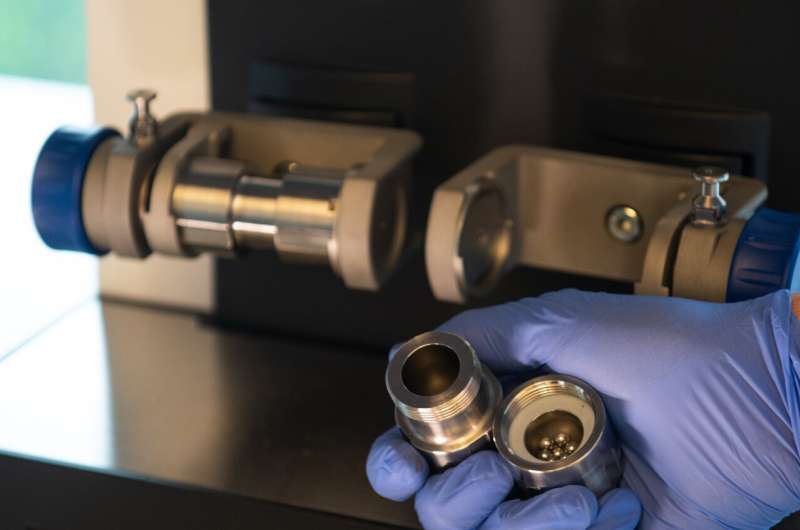Science
Abrasion Transforms Common Tools into Catalysts for Chemistry

The chemical industry is undergoing a significant transformation, as new research from the Okinawa Institute of Science and Technology (OIST) reveals that abrasion can enhance mechanochemical catalysis. Published in Angewandte Chemie, this study illustrates how common grinding tools can unexpectedly activate chemical reactions, prompting a reevaluation of established methodologies.
Revolutionizing Mechanochemical Reactions
Mechanochemistry, a growing field within chemical synthesis, utilizes mechanical force to mix reagents, reducing the need for solvents and increasing sustainability. Traditionally, researchers believed that adding solid, insoluble materials like metal oxides or piezoelectric substances activated catalysts. However, this new research indicates that the wear from grinding balls, typically made of stainless steel, plays a critical role in the reaction process.
The study highlights that abrasion from these materials can produce metallic contaminants that enhance the efficiency of chemical reactions. The researchers focused on cross-coupling reactions, which are vital for synthesizing various chemicals. They discovered that reactions conducted in a stainless-steel environment yielded successful results, while those performed in ceramic containers with ceramic balls failed to achieve the same outcomes.
Key Findings and Implications
Analysis revealed that the stainless-steel grinding balls released iron, chromium, and other metals into the reaction mixture. This contamination activated a stable nickel pre-catalyst, transforming it into an active catalyst. The research team employed various microscopic and spectroscopic techniques to study these reactions, demonstrating the importance of both additives and equipment in mechanochemical processes.
“This research changes the way we think about mechanochemical catalysts,”
said Professor Julia Khusnutdinova, head of OIST’s Coordination Chemistry and Catalysis Unit. “It highlights the importance of both the additives we use and the equipment itself in driving mechanochemical reactions, helping us to consider the hidden influences that may play a part in our reaction mechanisms.”
First author Thomas Hasiweder emphasized that researchers should consider the impact of abrasion on chemical reactions. “We have proven that abrasion can play an important role in mechanochemical catalysis,” he noted.
While the study warns of potential complexities associated with mechanochemical mechanisms, it also opens up new possibilities for cost-effective catalysis. The researchers plan to explore the scope of reactions where abrasion plays a significant role, aiming to develop simple protocols for a range of mechanochemical syntheses.
Professor Khusnutdinova expressed optimism about future research: “With this knowledge, we can create simple cheap protocols for a wide range of mechanochemical syntheses, opening up new avenues to essential agrochemicals, drugs, and beyond.” This research not only enhances understanding within the field but also paves the way for greener chemical production methods.
For further details, refer to the study: Thomas J. Hasiweder et al, “Mechanically Induced Nickel‐Catalyst Activation in Cross‐Coupling Reactions by Abrasion,” Angewandte Chemie International Edition (2025), DOI: 10.1002/anie.202520572.
-

 Technology5 months ago
Technology5 months agoDiscover the Top 10 Calorie Counting Apps of 2025
-

 Health2 months ago
Health2 months agoBella Hadid Shares Health Update After Treatment for Lyme Disease
-

 Health3 months ago
Health3 months agoErin Bates Shares Recovery Update Following Sepsis Complications
-

 Technology4 months ago
Technology4 months agoDiscover How to Reverse Image Search Using ChatGPT Effortlessly
-

 Technology1 month ago
Technology1 month agoDiscover 2025’s Top GPUs for Exceptional 4K Gaming Performance
-

 Technology2 months ago
Technology2 months agoElectric Moto Influencer Surronster Arrested in Tijuana
-

 Technology5 months ago
Technology5 months agoMeta Initiates $60B AI Data Center Expansion, Starting in Ohio
-

 Technology5 months ago
Technology5 months agoRecovering a Suspended TikTok Account: A Step-by-Step Guide
-

 Health4 months ago
Health4 months agoTested: Rab Firewall Mountain Jacket Survives Harsh Conditions
-

 Lifestyle5 months ago
Lifestyle5 months agoBelton Family Reunites After Daughter Survives Hill Country Floods
-

 Technology4 months ago
Technology4 months agoHarmonic Launches AI Chatbot App to Transform Mathematical Reasoning
-

 Technology3 months ago
Technology3 months agoUncovering the Top Five Most Challenging Motorcycles to Ride











